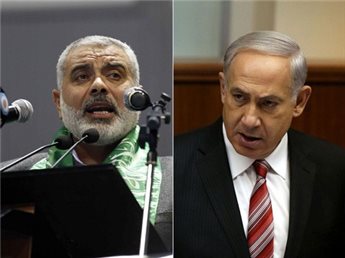Every good contract or agreement ends with a breach clause – what do you do if one or both sides fail to implement the agreement? The six failed agreements signed all lacked implementable breach clauses to determine what to do when one side or the other claimed breaches by the other side. There were no real-time on-the-ground means to address conflicts when they arose so that many minor issues which should have been solved on the ground ended up reaching the desk of the President of the United States. There was no mechanism devised to have responsible and trusted third-party monitoring, verification and compliance of the implementation of obligations of the parties to the agreements. They did not address in a satisfactory way the necessary fundamental means to build peace between the two peoples, to address incitement against peace, or to deal with educating for peace. That is why over the past decades it has been so dismaying to hear so many Israelis and so many Palestinians say “We want peace, but they do not!”. Both sides have had ample evidence to point to the lack of desire of genuine peace by the other side.
After this horrible war, we will all be confronted once again with the prospect of the two states solution. As a proponent of that solution for most of my life, I was having to deal with its seemingly lack of viability over the past years. Netanyahu’s strategy of removing the Palestinian issue and with it the two-states solution from the regional, global and even local agenda had succeeded until it blew up in our faces on October 7. It should now be quite apparent to all that the most fundamental issue of consequence, the primary existential issue facing Israelis and Palestinians, is the conflict between them. This conflict cannot be managed. It also cannot be strategized away unilaterally by the stronger side of the conflict.
Both peoples have to understand that empowering political parties that are devoted to destruction of the other side must be removed from their ability to destroy us all. Hamas cannot be a partner for peace with Israel, that is their clear choice and Israel and the Palestinian people must do everything in its power to remove Hamas’ ability to ever rule the territory next to Israel. Israeli political parties like Otzma Yehudit and the Religious Zionist Party which are both dedicated to the ethnic cleansing of Palestinians from the land and the settlement of Jews in their place, should not be allowed to be in positions whereby they will continue to bring death and destruction to this land and the peoples on it.
When we return to the efforts of trying to make peace again, it is essential that we learn the lessons of the failed peace process and that we not make the same mistakes over again. I will attempt to describe some of the failures and the prescriptions which can assist in avoiding those mistakes. This is not a comprehensive list. I have written many articles over the years on what went wrong in the peace process as well as many articles about “lessons learned”. They can all be found easily with a search on the internet. Each one of the issues presented here is worthy of a full article and perhaps I will go into more depth in the future.
Negotiations and Agreements based on no trust or negative trust – let’s not be naïve!
New agreements between the parties must be based on a complete lack of trust between them. The agreements can contain no naiveté whatsoever. We must base what we agree to on the assumption that the other side will not fulfill the obligations it takes upon itself in good faith. The other side will be carefully watching how the opposing side relates to its own obligations and will move ahead slowly and with caution, step-by-step based on the progress of the other side. These kinds of agreements in conflict situations enable the parties to take minimal risks and concessions while enabling the end game to remain in focus, but in the distance. This is an intelligent agreement and while negotiating in this way is cumbersome and difficult, it will lead to having better agreements.
End-Game Up Front
The Palestinians believed that the end-game of the Oslo peace process would be the establishment of an independent Palestinian state next to Israel on the basis of the June 4, 1967 borders. From the Palestinian point of view, their leader, Yasser Arafat made the ultimate concession by recognizing Israel on 78% of the land of historic Palestine. They expected and agreed to establish their state on only 22% of historic Palestine. The Palestinians could have demanded that new borders be based on the map of the Partition plan of 1947, but they came to recognize that their failure to accept the 1947 UN Resolution on partition costs them valuable parts of the homeland. In November 1988 when Arafat declared the State of Palestine it was understood that he accepted Israel on the June 4, 1967 and expected to establish the State of Palestine in the territories conquered by Israel after June 4, 1967 – the West Bank, Gaza, and East Jerusalem. The Oslo agreements never spelled out the end-game and Israel never explicitly agreed to the two states solution. No government of Israel, nor any Knesset ever voted to support the two-states solution. The Oslo process continued for 30 years without any and game specificized even though it was intended to be a five-year interim agreement. This is just another of many reasons why most people lost faith in the Oslo peace process. In any new peace process that will no longer be possible. If there is going to be a genuine peace process, one that has the power to challenge and confront the idea of Hamas, it must include explicitly and from the outset that the process will lead to the formal establishment and recognition of the State of Palestine by Israel within a period of time specified in the agreement. The time frame should be around five years but it should also be specified that the time line is based on the complete fulfilling of the obligations taken by the two sides on themselves. There can never again be an opened ended peace process that allows for negotiations to continue indefinitely without a known and accepted end-game from the outset. The OECD states, led by the United States should recognize the State of Palestine as soon as possible and enable the State of Palestine to become a full member state of the United Nations. We have had 30 years of talk about a two state solution while almost all of the OECD countries have only recognized one of the states – that needs to change.
Measurable Benchmarks and Third-Party Monitoring and Verification
Because we have experience with both sides failing to implement their obligations that they took upon themselves and because we have no confidence in new agreements being more adhered to than in the past, we need to have in place a robust mechanism that will monitor implementation and verify the completion of measurable benchmarks that must be completed before taking on additional risks. The benchmarks need to be identifiable and agreed on as part of the negotiated agreements. Effective and efficient monitoring, verification and compliance arrangements are increasingly seen as indispensable to the proper functioning of international agreements in a wide variety of fields. This includes traditional arms control and disarmament agreements, but also peace accords, or aspects of them, such as ceasefire, demilitarisation or decommissioning arrangements. Monitoring and verification are also increasingly spreading beyond military-related agreements to environmental, human rights and electoral issues. Indeed, monitoring and verification can be applied to virtually any agreement between two parties. Monitoring and verification may be done unilaterally by the parties, cooperatively between them or by a neutral third party, or by a combination of all three methods. In the Israeli-Palestinian case, I believe that the monitoring and verification mechanism must be done a third-party group of countries led by the United States. Learning from the failed “Road Map Process” which included a “Road Map Monitor” who did his job but his reports were not public, it is essential that the reports of the Monitoring and Verification mechanism be public so that the parties are accountable to their own public for their successes and failures at implementing the obligations they took upon themselves. Monitoring and verification is particularly useful in cases where, despite agreements being reached, deep distrust and suspicion remain between the parties, as in the Israeli-Palestinian case.
Public Support of Peace – Starting with Education and Incitement
What we teach our children is the best reflection on our values and on what we believe in. If the next peace process will be genuine, it will have to begin with the understanding that we must make educational reform from day one. This will be the very barometer on the seriousness of our intentions regarding our willingness to live in peace with our neighbors. No one agrees to be told what they should teach their own society. Both sides of the conflict have their own narrative of their own history and their own need to build their national identity. It is more than legitimate for Israelis and Palestinians to teach their own narrative of the conflict in which the other side is responsible for horrific acts of violence against the other side. Each side can legitimately describe itself as a victim in this conflict. The key issue is what is going to be taught regarding the future and the basic right of the other side to exist and to achieve self-determination. Because both sides reject the criticism of their curricula and text books done by the other side, the best workable solution is for the parties to agree on criteria of the evaluation and assessment of educational curricula and text books. Such work of developing internationally acceptable criteria has been done extensively by UNESCO and other organizations. The parties need to agree on criteria and then each side should undergo a process of conducting an assessment and evaluation of its own educational curricula and text books based on those criteria. A time line should be set for the work including the issuing of an interim report and a final report. Following the issuing of the final report a time line for educational reform should also be established. This work should be monitored and verified by the International Monitoring and Verification Mechanism. The reform of curricula and text books by both sides will be a true measure of the extent to which both sides are entering and progressing in a peace process which will be genuine and perceived across the conflict line as a determined decision to actualize peace between them.
No Constructive Ambiguity
The Oslo agreements were packed with Constructive Ambiguity (a termed coined by Henry Kissinger to enable both sides to an agreement to understand what they want from it). The best example is that nowhere in the six agreements signed is there an explicit statement that Israel would not build new settlements in the occupied territories. The Palestinians implicitly understood that if Israel is going to withdraw from territories to transfer them to the Palestinian Authority, then they would not be building more settlements. Israel claimed that building settlements was not in violation of the agreements and that settlements could also be removed. Both sides were able to interpret the agreements as they wished. Another case in point is that the agreements did not specify from what territories Israel would withdraw. The agreements led the Palestinians to believe that they would be in control of more than 90% of the West Bank even before they began negotiations on permanent status. The Israelis interpreted concepts like “specified military locations” into security zones so that the entire Jordan Valley was a security zone from which Israel did not withdraw. The Palestinians interpreted specific military locations as army bases. In any new agreements, there is no room for constructive ambiguity. Everything must be explicit and interpreted by both sides in the same way and if differences arrive, they should be brought to the third-party monitoring and verification mechanism.
There are many other lessons learned and insights on how to negotiate better agreements and raise the chances that genuine peace could be attainable. I will continue to write on this subject as we move forward towards the end of the war and beyond.



